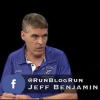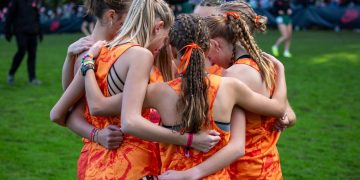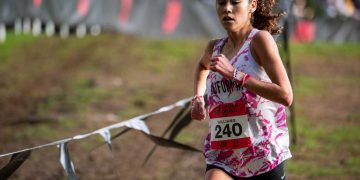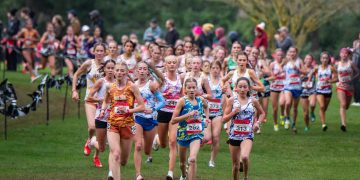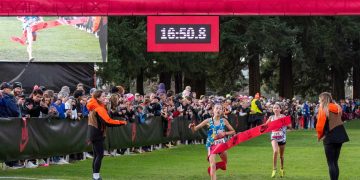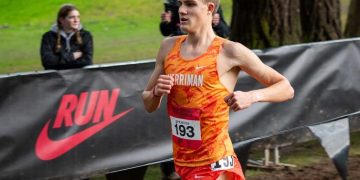In 1983 American Scott Rider had hit the world-class scene, as the Ohio High School State Champion would toe the line hoping to battle against Coe in that world record 800 race.
This writer caught up with Ryder, who fights a different yet inspirational battle today, which has been shaped by his experiences in the World-Class stage.
In ninth grade, I ran 2:08 in the 880, and that became my event for some reason. In January of my 10th-grade year, I ran an indoor track meet with no training and ran a 4:17 mile. To this day, I regret not moving up to the 1500/mile. I think I would have had more success in the mile vs the 800m.
I could go on and on, but the bottom line is that I always loved to run. In high school, I was twice the state champion in the large division of Ohio high school athletics, running 1:52.4 as a senior. Interestingly, I just narrowly missed making the state track meet in the 100. I had run a 10.8 100m earlier in the season, and for some crazy reason, I wanted to try to make the state meet in the 100 and 800. In retrospect, I’m glad that I did not make the state meet in the 100.
2) How were you selected to run in the 800 race vs. Seb Coe?
Scott Rider: “In 1983, I was having a good indoor season. I actually finished second in the Mobile Grand Prix behind Mark Belger. I don’t remember all the details about the season, but I remember I won the 800 or the 1000 in meets such as the LA Times, Cleveland, KofC, Louisville, and Chicago. I did not perform well in the indoor championship meet. I am not referring to the collegiate championships but the national championship meet that included professionals.
In 1982, my senior year at Ohio State, I finished the season as the number 10 ranked 800 m runners in the US, according to track and field news.
Originally, I was not selected to run in the race in Cosford. I don’t remember all the details except that the head coach at UCLA was the national coach who selected the runners for the USA versus England meet. He selected another athlete ahead of me for the meet who had run at UCLA even though I beat that runner countless times. I was very disappointed that I wasn’t selected for the team and was preparing to run in an indoor meet in Japan. But at the very last minute, I received a phone from the head coach of the US team, who was also the UCLA coach, and he informed me that the runner he had selected was injured and could not go to the meet and asked if I would like to take those runners to place. My teammate, who was a personal friend named Gerald Masterson, also had pleaded with the coach on my behalf. Thankfully, I was selected to be one of the two 800 m runners for the USA. Before running in Cosford, we ran in a meet in Milan. I don’t remember all the details except that I won the 800 in the meet in Milan.”
3) What are your recollections of the race & how did you feel?
Scott Rider: “It’s amazing that my recollections of the race are very clear to this day. My recollections might be very clear because I watch the race on YouTube probably more than 100 times! However, what I do remember is that I was not nervous. I also remember thinking to myself after going through the first 400 pretty darn fast and that this is going to be a crazy race. I was very much to take back.
I had passed the rabbit, and Seb Coe went through the first 400 meters. I remember feeling pretty darn good at some point in the race and decided that I was going to pass my teammate and then try to pass Peter Elliott.
Again, having watched the race many times on YouTube, I realize in retrospect how stupid I ran from a strategic standpoint. I continually tried to pass Elliot, who would shift his position in line one, forcing me into lane 2! Obviously, this consumes a lot of energy. I am not suggesting I would have won the race, but I do think I could’ve finished closer to Elliot, and I just stayed right behind him rather than trying to pass him countless times. If I’m not mistaken, I ran 1:48, which was a respectable time indoors back in 1983. I will always believe I couldn’t run much faster in some respects.
That race was the beginning of the end of my running career. That race helped me understand just how fast one would be to be world-class.
I recently read an article about Eric Sowinski, who has made a great career out of being a rabbit. The author of the article listed times and said if someone ran 1:46 today, they were elite but not world-class. I agree with that assessment. My best time ever was 1:46.6!
4) Did you have any interaction with Seb or Peter Coe during that time? Also – did you encounter Seb in any past/future races?
Scott Rider: “My only interaction with Seb was prior to the race. He wished me well in a very kind manner. It was clear to me that he was a gentleman. I had no interaction with Peter Coe or ever had an encounter with Seb afterward. In the summer of 82 and 83, I competed overseas and ran as a rabbit in several high-profile races, such as the DN Galen Games when Sidney Marie attempted to break the world record in the 1500.
Interestingly, while with the Santa Monica track club, I trained with Johnny Gray and David Mack on a daily basis for more than a year. That was an adventure in itself! I participated in some amazing workouts, where I held my own against two of the greatest 800 m runners in the history of the USA. Lots of stories associated with that time in my life.”
5) 1983 was the pre-Olympic year – how’d you do in 1984, and when did you retire from the Sport?
Scott Rider: As referenced above, I left Columbus in early 1983 and moved to Los Angeles to train with the Santa Monica track club. My college track coach was battling cancer, and I thought moving to Los Angeles was right. In retrospect, it was a huge mistake. I was never the same runner again I qualified for the 84 Olympic trials and was eliminated on the very first day.
I was devastated and humiliated…just two years before, I’ve been amongst the top 10 in the nation, and in ‘84, was nowhere near the runner had been previously. I realized it was time to move on in life and pursue a career.
So after staying in Los Angeles for about another year and a half, my wife and I moved back to Columbus, found jobs, and eventually started a family. I will never regret my time in Los Angeles as my experiences, mostly experiences of failure and humiliation, have become VERY valuable in helping me battle the biggest race of my life.
That race is against Parkinson’s.
Today I’m 63 years old and was diagnosed with Parkinson’s at age 47.
Only 1/2 of 1% of people who have Parkinson’s are diagnosed at such a young age.
Life is a daily struggle but making it and trying to make a difference. My failures experienced during running are what helped me to battle Parkinson’s today. I realize that life is not always what we expected or hoped it would be.
I often say that having Parkinson’s is like finishing second in a race. Very disappointing, but one has the decision to make – quit or get up off the track and try to get better, and that’s what I always did. That’s what I do today on a daily basis.I try to battle Parkinson’s through attitude, exercise, and strong personal faith. Life is not what I thought it would be; running didn’t turn out the way I thought it would either, and that’s OK. The most important thing in life is relationships, and I’m not sure that I would’ve learned that as early in life as I did had I not been diagnosed with Parkinson’s. My experiences with running, which were mostly failures. If you really stop and think about it, taught me how to battle and carry on in spite of disappointments.
I finished second in the Big Ten five times and was a Big Ten champion once in a 4 x 4 hundred meter relay and twice in 800 m. Looking back at my entire running career from seventh grade to the very end of my career running for the Santa Monica track club, the single highlight of my career was the race against Seb Coe. Halfway through that race, we went through so fast I thought I will never finish this race. But I carried on and ran a respectable time. Most importantly, I learned that never quitting in spite of challenges is what’s most important. Had I bailed out after the second lap of the race against Coe, I would never be able to say that in a very small way, I was part of history.
Not many people on this earth have had the opportunity to participate in a race where the world record wasn’t smashed; it was obliterated. Being part of that race and against such a fine gentleman such as Seb Coe was an amazing experience. It’s an experience that has impacted my life in more ways than most people would understand. I truly believe that I would not have the internal fortitude to battle Parkinson’s had I not participated in that race.
6) Are there any runners you keep in touch with?
Scott Rider: “Sure, a lot of the guys, and recently I spoke with Frank O’Mara!
7) Please share your fight with Parkinson’s and how you’ve raised $$ for the cause.
Scott Rider: Thank you for asking about Parkinson’s! There is an irony associated with my diagnosis. I was once pretty fast, and Parkinson’s makes you very slow. However, I decided early on that I could be a contributor or a consumer. What I mean is that I could contribute to the cause, find ways to help others who have Parkinson’s and their caregivers as well as raise funds to help find a cure. The other option would have been to strictly lay low and take advantage of all the resources and information made possible by others’ hard work. I’m not saying that everybody is cut out to being a contributor. However for me, I find great satisfaction in being a contributor.
I have raised nearly $700,000 for the Parkinson’s Foundation. I regularly speak to groups all across the USA to raise funds and awareness.
Of course, any successes I have had are only made possible by the generosity of others. My fundraising projects have included events such as moving day and Parkinson’s Revolution, both of which are events organized by the Parkinson’s Foundation. Additionally, I have been involved in raising money through projects, such as the adaptive college featured in the southern living magazine, to benefit to Parkinson’s Foundation. At the present time, I’m working on a Parkinson’s and Pickleball project, which was just featured on the CBS Sports Network.
link-
Also, last year I traveled nearly 80 thousand miles with a film crew that’s part of what is called Parkinson’s across America. Along with my good friend Jim Morgan who has Parkinson’s, we are working on a documentary with the help of some of Hollywood’s best!
Anything that I can do to increase awareness about Parkinson’s is considered a WIN !”
7) You mentioned Seb Reached out to you after your diagnosis – how’d that happen, and how do you feel about it?
Scott Ryder: “Since being diagnosed with Parkinson’s disease, I’ve had surgery for colon cancer, two back surgeries, knee surgery, hammer toe surgery, detached Achilles surgery, and at least one other surgery.
Before one of the surgeries, I was in transit and checking my email. The email said that I received an email from Seb Coe. Of course my first thought was, “there’s no way”! However, in fact, Seb Coe did send me an email where he mentioned the race at Cosford and wished me the best of luck regarding the surgery and healing fast.
The letter was made possible by a friend and neighbor here in Habersham, South Carolina, where I live at present.
I can tell you that tears came down my cheeks when I read the letter. I was struck by the kindness by the fact that somebody as prominent as Sebastian Coe would take the time to send me an email.”
To donate to the fight against Parkinson’s in honor of Scott Ryder, please go to
On the landing page in the top right corner, please click on the donate button where you can make a donation in honor of Scott!
Americans Scott Rider & Gerry Masterson with a young Seb Coe fan at the 1983 GB vs. USA meet in Cosford. Pic courtesy of Scott Rider.
2019 Letter from Seb Coe to Scott Rider.
Courtesy of Scott Rider.
